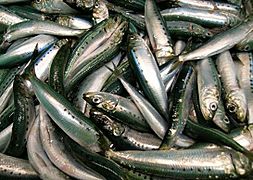Sardinops facts for kids
Quick facts for kids Sardinops |
|
|---|---|
 |
|
| Scientific classification | |
| Kingdom: | |
| Phylum: | |
| Class: | |
| Order: | |
| Family: | |
| Genus: |
Sardinops
C. L. Hubbs, 1929
|
| Species: |
S. sagax
|
| Binomial name | |
| Sardinops sagax (Jenyns, 1842)
|
|
Sardinops sagax is a type of sardine fish. It belongs to a special group, or genus, that only has one kind of fish in it. This fish is found in the Indo-Pacific and East Pacific oceans. It can grow up to 40 cm (16 in) long.
People call Sardinops sagax by many different names. Some common names include blue pilchard, Australian pilchard, Californian pilchard, Peruvian Pacific sardine, South American pilchard, Chilean sardine, Japanese pilchard, and Pacific sardine.
Contents
Fishing for Sardines in South Australia
The South Australian sardine fishery is a big fishing industry. It catches a lot of Sardinops sagax fish. In fact, it catches more fish by weight than any other single type of fish in Australia.
How Sardines Are Caught
Fishermen use a method called purse seining to catch these sardines. They use a very long net, sometimes up to 1 kilometre (about half a mile) long. This net is used to surround a large group of sardines.
Once the fish are surrounded, the bottom of the net is pulled closed, like a drawstring purse. The fish are then pumped from the net onto the fishing boat. They are kept very cold in special refrigerated areas on the boat.
What Happens to the Catch
Most of the sardines caught, about 94%, are used as food for Southern bluefin tuna. These tuna are raised on farms near Port Lincoln, South Australia. The remaining 6% of the sardines are used for other things.
Some sardines are sold for people to eat. Others are used as bait for recreational fishing. A small amount also goes to make premium pet food.
Fishing Quotas and Rules
The sardine fishing industry in South Australia started in 1991. Back then, they were allowed to catch 1,000 metric tons (980 long tons; 1,100 short tons) of sardines each year. This limit is called a quota.
Over time, the quota increased. By 2003, the yearly quota was 36,000 metric tons (35,000 long tons; 40,000 short tons). In 2014, it went up to 38,000 metric tons (37,000 long tons; 42,000 short tons). The most fish caught in one year was 56,952 metric tons (56,053 long tons; 62,779 short tons) in 2004-05. After that, the amount caught usually stayed around 32,000 metric tons (31,000 long tons; 35,000 short tons) per year.
It's important for everyone in the fishing industry to follow the rules. This means reporting all the fish they catch. It also means not catching more fish than their allowed quota.
Gallery
-
A school of S. sagax in the Open Sea exhibit at Monterey Bay Aquarium
See also
 In Spanish: Sardinops sagax para niños
In Spanish: Sardinops sagax para niños





